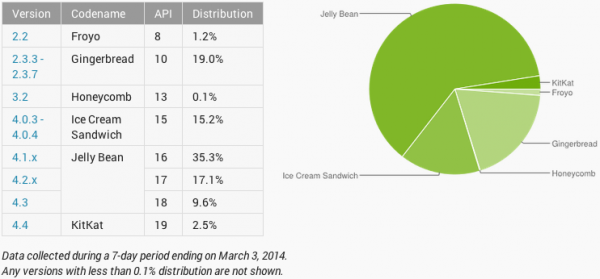
Google's Android distribution charts give us a fresh look at adoption trends with each monthly update. In early-March, we see Jelly Bean and KitKat continuing their rise in popularity, while older iterations of the popular open source operating system are on their descending path.
Based on the number of devices accessing the Play store in the seven days ending March 3, KitKat is running on 2.5 percent of monitored Android handsets. Its distribution share is 38.88 percent higher compared to the previous month, when it accounted for 1.8 percent. KitKat will see a stronger uptake once smartphones like the new Samsung Galaxy S4 are released, and vendors upgrade their existing devices to the latest Android iteration.
Jelly Bean also has an increased its distribution level in early-March, reaching 62 percent of monitored Android devices. Its share increased slightly from a month before, when it topped 60.7 percent. The individual iteration breakdown is as follows: Android 4.1 -- 35.3 percent (previously 35.5 percent), Android 4.2 -- 17.1 percent (previously 16.3 percent) and Android 4.3 -- 9.6 percent (previously 8.9 percent). More recent Jelly Bean versions will continue to grow further, as vendors are still launching devices, and software upgrades, with those distributions.
Ice Cream Sandwich sees a drop in distribution, to 15.2 percent early this month from 16.1 percent a month before. Android 4.0 already has two years on the market under its belt, which, combined with the higher popularity of newer sweets, accounts for its slide.
Honeycomb is again showing up in the charts, despite its mere 0.1 percent distribution. Needless to say, its presence is conditioned by the 0.1 percent mark that is imposed by Google for a distribution to be included in monthly updates. Its level is unchanged over previous reports.
Like Ice Cream Sandwich, Gingerbread is also bleeding distribution. Early this month, it topped 19 percent, 1 percentage point less than a month ago when it had 20 percent. The drop comes naturally, as more recent Android iterations are favored by vendors for their latest devices and new software upgrades.
Froyo follows in the footsteps of its younger siblings, by ceding distribution. It topped a mere 1.2 percent, which is slightly lower than early last month when it accounted for 1.3 percent of monitored Android handsets.

The latest Android distribution update does not reveal anything out-of-the-ordinary, as newer sweets increase in popularity while older iterations are slowly, but surely, on the path towards platform irrelevance.
Photo Credit: rangizzz/Shutterstock

